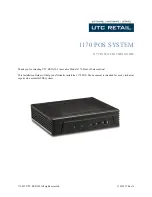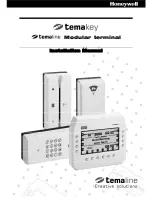
20
ENTER TRANSMITTER
CODE.
COD:
ACTIVATE CHANNEL
TO CANCEL...
WAIT............
CODE SEARCH IN
PROGRESS
INSERTED CODE
CANCELLED!
INSERTED CODE
DOES NOT EXIST!
ENTER MEMORY
LOCATION NUMBER:
LOCATION:
INFORMATION...:
A-NUMERICAL CODE
B-VIA RADIO
C-LOCATION
TRS INFORMATION:
LOC.:
COD.:
CH. :
and if it is not accepted it means that the maximum number has been surpassed. Press
"
ENT" to confirm the selected value (if it is out of limits, e.g. zero is shown on the display,
the location memory will not change as zero is not allowed). Pressing "
ESC" will take you
back to the previous menu and completely ignore the insertion.
This message appears during the cancellation via radio function and indicates that you
have to press the button of the transmitter corresponding to the function that you wish
to cancel from memory. This message remains fixed on the display until either a value is
input or the quit command is pressed ("
ESC" button).
Indicates that the code received via radio is being searched for in the external memory
module. This message appears during the cancellation via radio function as searching
high memory can take several sections. Depending on the outcome of the operation you
will either be moved back to menu nr.
12
or
13
.
Stays on the screen for about 1 second and confirms that the code has been cancelled by
means of the "via radio" function. You are automatically moved back to menu nr.
10
.
Lets the user know that the function you wished to cancel is not present within the memory
module. You are automatically moved back to menu nr.
10
.
Asks you to insert the memory location. A limit control check is carried out depending on
the type of memory which is detected in the external socket. Press "
ENT" to confirm the
selected value (if it is out of limits, e.g. zero is shown on the display, the location memory
will not change as zero is not allowed). Pressing "
ESC" will take you back to the previous
position and completely ignore the insertion.
Looks up all the information regarding a transmitter inside the memory module that has at
least one of the three necessary search keys.
A)
Searches throughout the memory for the transmitter's numerical code and displays
each location in which it appears. If the search returns a valid result the information will
be displayed (menu nr.
16) otherwise you will be taken back to menu nr. 09
(inserting the
transmitter's identification code).
B)
Searches throughout the memory for one of the transmitter's functions (received via
radio) and displays each location in which it appears. You are moved directly to menu nr.
16 where the program waits for a transmission by the user. This function does not require
the presence of an external memory module as it can be used to recognise the identity
number of a transmitter (the location and channel numbers remain empty).
C) Shows transmitter information by only knowing the position it occupies in memory. If a
code is present it will be shown on window nr.
16
will appear along with all the information
regarding the position. If the location is empty you will be taken back to window nr.
14
.
Shows all the information relative to a transmitter. This screen is shown while you are carrying
out various functions so it is impossible to give it a precise reference. This layout will show
all available information for a transmitter along with its memory location. The position the
transmitter occupies in memory will be shown in the second line, identified by "
LOC
", with
a number between 1 and 300 (in the case of a 300-code type memory module), or between
1 and 1000 (in the case of a 1000-code type memory module). The transmitter code will be
indicated in the third line identified by "
COD
". The information regarding enabled channels
for the transmitter will be shown in the fourth line indicated by the letters "
A,B,C,D". If a
letter is present that channel function is enabled.
NOTE: If you are using a 300-code type memory module in which each single channel
occupies a location you may see information for a number of transmitters (channel for
channel) by simply pressing the enter key "
ENT
". Each time you press "
ENT
" the search
for information carries on from that point until it has checked the entire memory. E.g.: if
the transmitter has 2 functions memorised in the positions
24
and
50
, the information for
position
24
will be shown and after pressing the "
ENT
" button the information for position
50
will be shown. For the 1000-code memory modules everything will be shown at once as
long as the transmitter occupies one location.
09
10
11
12
13
14
15
16
Téléchargé sur www.confort-electrique.fr
Retrouvez tous les produits du fabricant Cardin sur notre site internet www.confort-electrique.fr
Téléchargé sur www.confort-electrique.fr
Retrouvez tous les produits du fabricant Cardin sur notre site internet www.confort-electrique.fr
















































